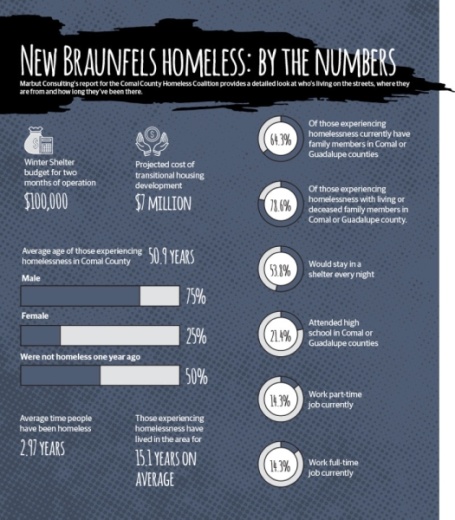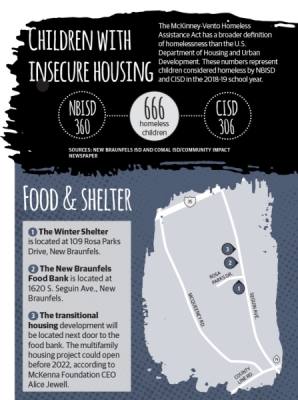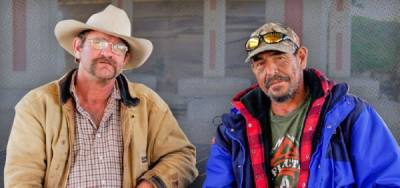The shelter—funded by the McKenna Foundation and operated by Connections Individual & Family Services in partnership with the Comal County Homeless Coalition—is the only homeless resource of its type in Comal County and is a stepping stone to future facilities.
“Now that we’ve been formally introduced, learned their needs and developed trusting relationships with them, we owe it to them and the community to realize a permanent resource,” McKenna CEO Alice Jewell said.
The next step is already on the horizon: a transitional housing development next door to the New Braunfels Food Bank.
Details are limited for now, but the $7 million housing project will include about 50 below-market-rate units, and groundbreaking is targeted for later this year with an opening in late 2021, according to Jewell. It will be a key resource in the coalition’s efforts to provide secure, affordable housing.
“I think there’s a little bit of a misconception in the community that comes from the lower unemployment rate that exists here,” NBFB Executive Director Monica Borrego said. “People need to understand that although some are employed here, the wages are not high enough to also afford them to live here.”
The coalition is a partnership of local organizations providing resources and short-term housing solutions to people in a variety of situations. According to Jewell, coalition members will be able to funnel people struggling with insecure housing into the application pipeline for the transitional housing project.
That will look different for each member of the coalition. Organizations such as Family Promise have helped more than 50 families get back on their feet by providing services and short-term accommodations at partnered local churches, according to Sarah Dixon, executive director at Family Promise of Greater New Braunfels.
“We’ll be one of the referring agencies,” Dixon said. “I really see that as being a big safety net for when public housing and vouchers aren’t available to get someone stable [housing].”
The San Antonio Food Bank is the NBFB’s parent organization and is managing the transitional housing project’s development, including fundraising.
The NBFB provides resources and classes to anyone within 185 percent of the poverty line, but NBFB Development Manager Louie Guzman explains that the food bank will still help people in need, regardless of their tax bracket.
“Unless you have deep savings you can be wiped out,” Guzman said. “We see that all the time.”
An evening in the shelter
In a flurry of motion, food is quickly gathered on a folding table by five guests and a Winter Shelter volunteer before it is stacked into a box. At the center of the action is a woman.
Shelter guest Brian Bargr, 50, has spent most of the evening outside in the cold air watching for her arrival to help her get in and out quickly. He later explains that the woman’s 24-year-old son is on a ventilator after a string of heart attacks caused by living in a house with black mold.
She is not homeless, but her resources are stretched thin, and the shelter is willing to help. The woman leaves with a box full of food held in her arms, and people begin settling in for the night.
There are 20 people filling cots when the doors are closed for the night. The shelter has a total of 24 cots packed tightly together, with a divider running between men’s and women’s areas. On average, 21 people take shelter here every evening, according to Jewell.
Among the guests, Mark Boehringer is a former Army Ranger and another veteran, Cowboy, says he was a Navy SEAL.
A few people sit at a table between the kitchenette and cots to watch a small TV atop a shelf. Guests take turns using the two stalls in the mobile shower trailer parked on the lawn near the back doors.
A few people are already sleeping with blankets pulled over their heads, shielding themselves from noise and fluorescent lights. Kellie Stallings, Connections Individual & Family Services executive director, takes breaks from organizing supplies to check on guests.
Before the shelter opened, Bargr was taking shelter in all-night diners. He starts a surveying job as soon as his Social Security card arrives. He has plans to rent a place of his own soon, but he’s been on the streets for two years.
Bargr says he would take advantage of transitional housing if it were available today. He has the shelter until it closes Feb. 25.
“This place is perfect,” Bargr said. “It’s got my license back and helping me get my Social Security card back.”
The Marbut report on homelessness
Recent breakthroughs in New Braunfels housing and shelter efforts can be traced to a report completed in November by Marbut Consulting for the Homeless Coalition, provided by McKenna.
In December, the firm’s namesake, Robert Marbut, was appointed by President Donald Trump as executive director of the U.S. Interagency Council on Homelessness.
While that appointment has some controversy attached to it due to Marbut’s policies—75 House democrats signed a letter in protest of the president’s choice—the 35-page report offers unique insights and suggests specific actions to assist the local homeless population.
The report says the average age of those experiencing homelessness in the area is 50.9 years, and 75 percent are male.
The report’s findings also state 50 percent of those experiencing homelessness locally have been so for less than a year but have lived in the area for an average of 15.1 years.
The report states that 64.3 percent of local homeless have family members living in Comal or Guadalupe counties. That number is even higher—78.6 percent—if one includes those experiencing homeless who had family members that lived here but died.
A caseworker at the temporary shelter, Briana Saltis, was recently reunited with a former high school classmate at the shelter.
Marbut’s report includes a poll that asked locals who are experiencing homelessness how often they would sleep in a permanent shelter. The poll said 53.8 percent said they would be there every night.
They also described three barriers holding them back: rising rental prices, comparatively low wage growth, and a lack of affordable or convenient transportation.
New approaches for a new decade
The report suggests a number of ways those experiencing homelessness can be helped in New Braunfels.
In reference to municipal policies, the report states, “A small investment, when combined with a focus on year-round residents, would have a huge positive impact in terms of the overall outcomes. Furthermore, smart and targeted investments could actually save funding that is currently being spent within the criminal justice, medical and non-profit systems.”
The first recommended action step is a permanent shelter with feasibility testing provided by a winter shelter. This is currently happening at the Winter Shelter.
Other suggestions include funding pools for homeless prevention efforts as well as substance treatment and recovery programs.
Transitional housing is also on the report's list.
The final two steps listed are to “establish service eligibility criterion” for who can receive assistance and “a zero-tolerance approach to encampments.”
The former suggests long-term and intermediate services should be restricted to individuals who are here year-round. Short-term services, less than seven days, would still be available to those without a “direct connectivity” to New Braunfels.
The zero-tolerance approach cites safety issues, health concerns and inadequate shelter as well as concerns for environmental issues, disease transmission and potential fire hazards.
One section of the report was dedicated to positive and negative observations. Marbut found it striking how much everyone interviewed for the report “genuinely likes each other and how well all the agencies work together to address the issues of homelessness in the greater New Braunfels community.”
“The people that are homeless are our neighbors—they’re from here,” Stallings said. “We as a community really need to think about what we’re going to do to solve that problem because it’s only going to get bigger.”
For those experiencing homelessness in New Braunfels, local resource information is available on Comal County Homeless Coalition's website.







